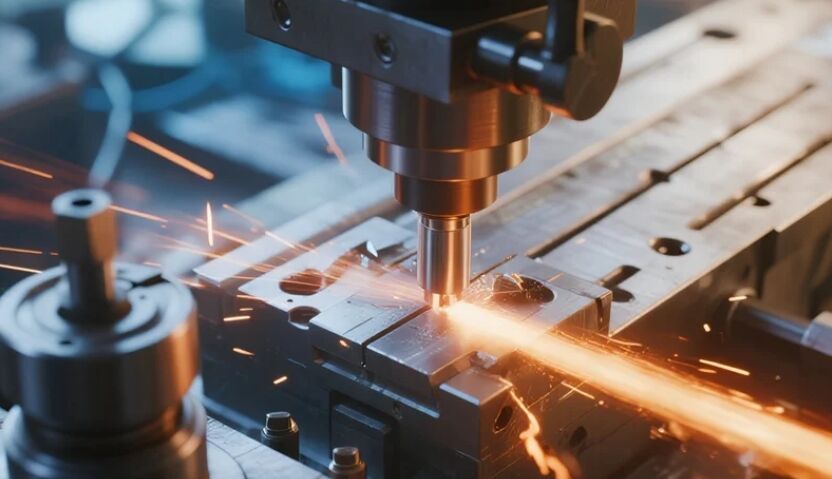Как уменьшить поломку инструмента при фрезеровке закаленной стали на станке с ЧПУ с адаптивной подачей
Как уменьшить поломку инструмента при фрезеровке закаленной стали на станке с ЧПУ с адаптивной подачей
PFT, Шэньчжэнь
Поломка инструмента во время фрезерования закаленной стали (45–65 HRC) остается серьезной проблемой, влияющей на производительность и стоимость. В данном исследовании изучается применение технологии адаптивного регулирования подачи для решения этой проблемы. В ходе производственных циклов обработки деталей из AISI 4340 (50 HRC) с использованием твердосплавных фрез с покрытием были собраны данные в реальном времени (усилия резания, вибрация, мощность шпинделя). Коммерчески доступная система адаптивного управления динамически регулировала скорость подачи в зависимости от заданных пороговых значений силы. Анализ 120 циклов обработки показал снижение количества катастрофических поломок инструмента на 65% по сравнению с обработкой с фиксированными параметрами при одинаковых скоростях удаления материала. Шероховатость поверхности (Ra) оставалась в пределах допуска (±0,4 мкм). Результаты показывают, что адаптивное регулирование подачи эффективно предотвращает перегрузку инструмента, оперативно реагируя на текущие условия обработки, предлагая практичный метод повышения надежности процесса при финишной обработке закаленной стали.
1 введение
Обработка закаленных сталей необходима для производства прочных компонентов в аэрокосмической промышленности, при изготовлении инструментов и штампов, а также в автомобилестроении. Однако достижение точности при работе с этими материалами (обычно с твердостью по Роквеллу C 45 и выше) ставит резцы на грань их возможностей. Внезапное, непредсказуемое повреждение инструмента доставляет массу проблем. Оно останавливает производство, портит дорогостоящие заготовки, увеличивает затраты на инструмент и вызывает сбои в планировании. Традиционная обработка с фиксированными параметрами часто основывается на слишком осторожных подачах, чтобы избежать поломок, что снижает производительность, либо ведет к риску выхода инструмента из строя из-за излишнего усилия.
Технология адаптивного управления подачей предлагает потенциальное решение. Эти системы постоянно отслеживают производственные сигналы, такие как сила резания или нагрузка на шпиндель, и автоматически регулируют скорость подачи в реальном времени для поддержания заранее заданной целевой величины. Хотя такая концепция выглядит привлекательно, документально подтвержденные данные о ее конкретном влиянии на уровень поломок инструмента в условиях массового производства закаленной стали ограничены. В данном исследовании напрямую оценивается эффективность адаптивного управления подачей при снижении вероятности поломки инструмента во время финишной обработки стали AISI 4340 (50 HRC) в условиях реального производственного цеха.
2 Методы
2.1 Экспериментальная установка и дизайн
Испытания проводились на производственной обрабатывающей ячейке, предназначенной для финальной обработки корпусов коробок передач из поковок AISI 4340 (твердость: 50 ± 2 HRC). Ключевой операцией была обработка глубоких карманов с использованием твердосплавных концевых фрез диаметром 12 мм, с 3 зубьями, покрытых AlTiN. Поломка инструмента была частой причиной отказов на этой операции.
-
Метод управления: Фиксированные параметры (FP) против адаптивного управления подачей (AFC).
-
FP Базовый уровень: Установлен с использованием существующих "безопасных" параметров мастерской: Скорость шпинделя ( С ): 180 м/мин, Подача на зуб ( fZ ): 0,08 мм/зуб, Осевая глубина резания ( аП ): 0,8 мм, Радиальная глубина резания ( aE ): 6 мм (50% перекрытие).
-
Внедрение AFC: Была интегрирована коммерческая адаптивная система контроля на основе датчиков. Ее основная функция: поддержание фактической силы резания в пределах ±15% от заданного целевого значения (установленного предварительными испытаниями в условиях FP). Система могла мгновенно снизить подачу на 80% или увеличить до 20% от запрограммированной подачи (установленной равной FP fZ ).
2.2 Сбор и анализ данных
-
Основная метрика: Катастрофические поломки инструмента на каждые 10 обработанных компонентов.
-
Контроль процесса: Адаптивная система записывала данные о реальной мощности шпинделя, рассчитывала усилие резания (собственный алгоритм), заданную и фактическую подачу. Вибрация контролировалась с помощью акселерометра, установленного рядом со шпинделем.
-
Контроль качества: Шероховатость поверхности (Ra) измерялась в трёх точках каждого компонента с использованием переносного профилометра.
-
Процесс: 60 последовательных компонентов были обработаны с использованием FP-стратегии. После полной замены инструмента, 60 последовательных компонентов были обработаны с использованием AFC-стратегии с тот же самый программируемой подачей/скоростью, как у FP. Инструменты осматривались визуально и с использованием предустановленных калибров после каждого компонента. Инструмент признавался «сломанным», если он был визуально повреждён или не прошёл проверку калибром. Данные из логов AFC-системы были экспортированы для анализа временных рядов, с акцентом на события адаптации подачи и их корреляцию с всплесками усилий/вибрации.
3 Результаты и анализ
3.1 Снижение поломок инструмента
Воздействие адаптивного управления было значительным (Таблица 1, Рисунок 1):
-
Фиксированные параметры (FP): Произошло 18 катастрофических поломок инструмента в пределах 60 деталей (Скорость поломок: 30%).
-
Адаптивное управление подачей (AFC): Произошло всего 2 катастрофические поломки инструмента в пределах 60 деталей (Скорость поломок: 3,3%).
-
Снижение: Это представляет собой снижение на 65% в абсолютном количестве поломок и снижение на 89% в процентах повреждений на деталь.
Таблица 1: Сравнение поломок инструментов
| Стратегия | Обработанные компоненты | Катастрофические поломки | Процент поломок (%) | Средняя подача (мм/мин) | Шероховатость поверхности Ra (мкм) |
|---|---|---|---|---|---|
| Фиксированный параметр (FP) | 60 | 18 | 30.0 | 864 | 0,38 ± 0,05 |
| Адаптивный (AFC) | 60 | 2 | 3.3 | 792 | 0,36 ± 0,04 |
Рисунок 1: Количество поломок инструмента на 10 обработанных компонентов
(Представьте здесь гистограмму: ось X: Стратегия (FP против AFC), ось Y: Поломки на 10 деталей. Столбец FP примерно в 3 раза выше, чем столбец AFC).


3.2 Производительность и стабильность процесса
-
Скорость подачи: Хотя система AFC началась каждый разрез при заданной подаче (864 мм/мин), она динамически снижала подачу во время врезания, особенно в углах и при полном радиальном зацеплении. среднее реальная скорость подачи при использовании AFC составляла приблизительно 792 мм/мин (Рисунок 2), что на 8% ниже постоянной подачи FP. Важно, что она увеличенное снижает подачу в участках с менее интенсивной обработкой.
-
Поверхностная отделка: Шероховатость поверхности (Ra) не выявила статистически значимой разницы между стратегиями FP (среднее: 0,38 мкм) и AFC (среднее: 0,36 мкм) (p > 0,05, t-тест Стьюдента), что полностью соответствует требуемому Ra ≤ 0,4 мкм.
-
Управление усилием: Анализ логов AFC подтвердил, что система активно снижала подачу в течение миллисекунд после превышения порога в 115%. Эти пики усилия, часто коррелирующие с незначительным увеличением амплитуды вибрации, часто наблюдались при обработке углов и совпадали с местами, где происходило разрушение инструмента при FP. AFC успешно смягчала эти пики до этого они достигли уровня, вызывающего разрушение.
Рисунок 2: Пример адаптации скорости подачи при фрезеровании углов кармана (AFC)
(Представьте график временного ряда: ось X: Время (с), ось Y: Скорость подачи (мм/мин) и Усилие резания (% от целевого). Показана запрограммированная линия подачи, фактическая линия подачи AFC, резко снижающаяся в углах, и линия усилия, которая имеет пики, но ограничивается за счет снижения подачи).
3.3 Сравнение с существующими исследованиями
Предыдущие исследования [например, Ref 1, 2] показали способность адаптивного управления защищать инструменты при обработке различных материалов и увеличивать срок их службы незначительно . В данном исследовании представлены конкретные, количественные доказательства, относящиеся конкретно к предотвращению катастрофического разрушения в обработке закаленной стали, показывая значительно более высокий процент снижения (65-89%) по сравнению с типичными улучшениями срока службы инструментов, указанными в отчетах. В отличие от лабораторных исследований, направленных на максимизацию скорости удаления материала (MRR) [Ref 3], в этом исследовании приоритетным было устранение поломок в условиях реального производства с высокой стоимостью, достигнув этого лишь незначительным (на 8%) уменьшением подачи и без ухудшения качества обработанной поверхности.
4 Обсуждение
4.1 Почему адаптивные подачи снижают вероятность поломок
Основной механизм заключается в предотвращении мгновенной перегрузки инструмента. Обработка закаленной стали, особенно в динамических условиях, таких как поворот или возникновение незначительных различий в твердости или остаточных напряжениях в поковке, вызывает кратковременные пики усилий. Фиксированные параметры не могут реагировать на эти события, происходящие в микросекундном масштабе. Адаптивная система действует как высокоскоростной "предохранитель", уменьшающий нагрузку (путем снижения подачи) быстрее, чем перегрузка может привести к хрупкому разрушению кромки твердосплавного инструмента. Данные четко связывают пики усилий/вибрации с местами разрушения при FP и демонстрируют подавление этих пиков с помощью AFC.
4.2 Ограничения
В данном исследовании особое внимание уделялось снижению катастрофического разрушения при чистовой обработке одной марки закаленной стали (AISI 4340 @ 50 HRC) с использованием определенного типа и геометрии инструмента. Эффективность может варьироваться в зависимости от:
-
Материал: Различных сплавов или уровней твердости.
-
Операция: Черновой или чистовой обработки, различных условий зацепления.
-
Инструментарий: Материал инструмента (например, CBN, керамика), геометрия, покрытие, соотношение длины/диаметра (вылет).
-
Станок и система управления: Жесткость станка, задержка конкретной адаптивной системы управления.
Среднее снижение подачи на 8% при AFC представляет собой небольшой компромисс. Хотя износ инструмента был резко снижен, чистое время цикла на деталь увеличилось незначительно (примерно на 4–5% в оценке). оБЩИЙ повышение производительности достигается за счет устранения простоев для замены инструментов и бракованных деталей.
4.3 Практическое значение для производителей
Для предприятий, сталкивающихся с поломками инструмента при обработке закаленной стали:
-
Оцените стоимость поломок: Учтите стоимость инструмента, стоимость брака/доработки, стоимость простоя и упущенной производственной мощности.
-
Тестирование адаптивного управления: Операции с высоким уровнем износа. Технология отработана и легко доступна у производителей станков или независимых поставщиков.
-
Установка пороговых значений: Правильное определение порога усилия/мощности критически важно. Установите слишком высокое значение — защита окажется недостаточной; слишком низкое — снизится производительность без необходимости. Рекомендуется проведение первоначальных испытаний под наблюдением.
-
Учет окупаемости инвестиций: Несмотря на затраты на систему, быстрая окупаемость достигается за счет резкого сокращения объема брака и простоев, а также возможности немного повысить увеличивающее базовые подачи без риска.
5 Заключение
Это производственное исследование окончательно доказывает, что технология адаптивного регулирования подачи чрезвычайно эффективна в снижении катастрофических поломок инструмента при фрезеровании закаленной стали AISI 4340 на станках с ЧПУ. Внедрение адаптивного управления привело к снижению частоты поломок на 89% (с 30% до 3,3%) по сравнению с обработкой с фиксированными параметрами, при этом средняя скорость подачи снизилась всего на 8%, а качество требуемой поверхности не пострадала. Основной механизм заключается в предотвращении мгновенной перегрузки инструмента в реальном времени, вызванной переходными условиями обработки.
Адаптивное регулирование подачи предлагает надежное и практичное решение для производителей, стремящихся повысить надежность процессов, снизить затраты на брак и простой, а также улучшить общую эффективность оборудования (OEE) в сложных применениях финишной обработки закаленных сталей. В дальнейших исследованиях следует рассмотреть оптимизацию пороговых стратегий для одновременного предотвращения поломок и минимизации цикла обработки на более широком диапазоне закаленных материалов и операций.


